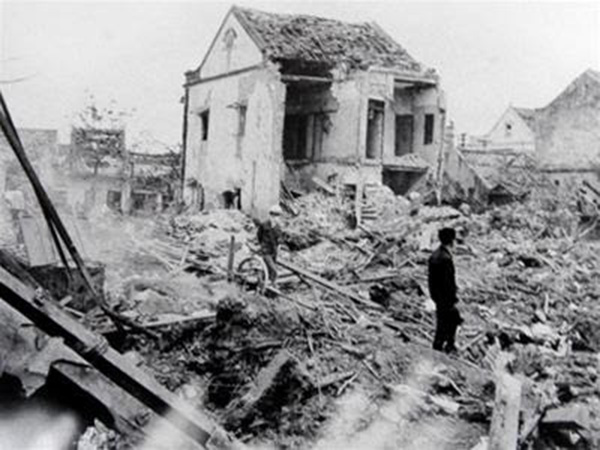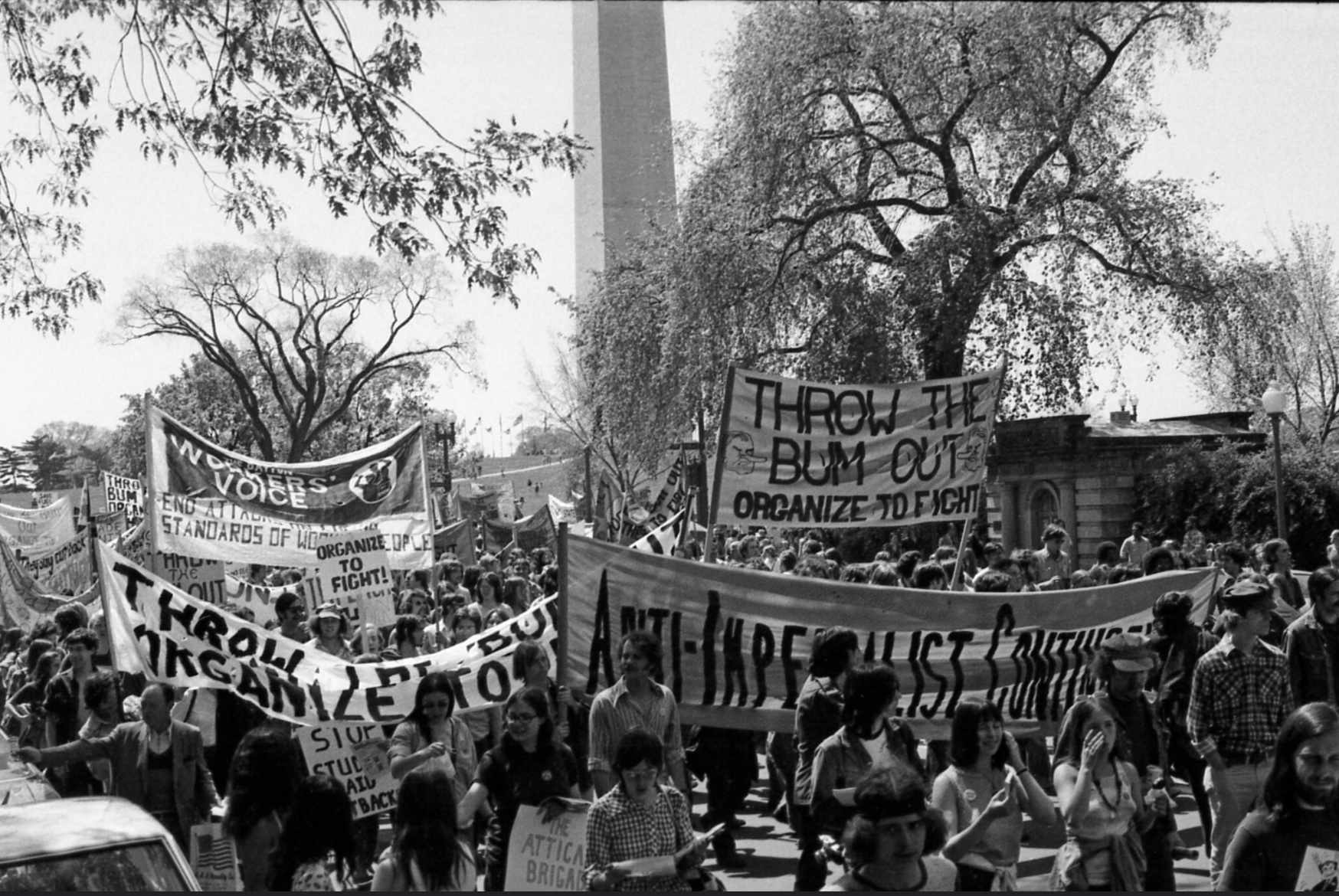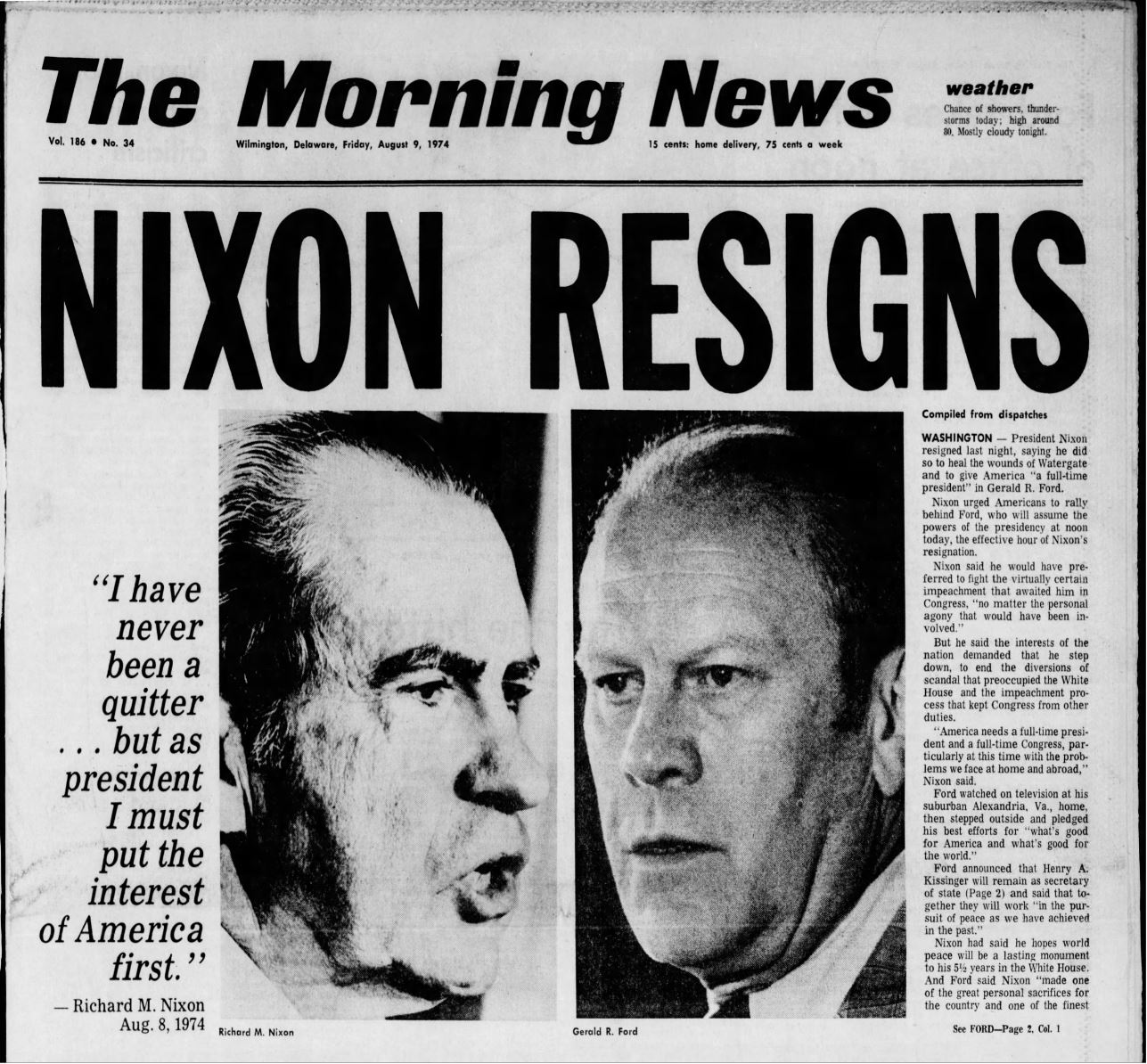“Throw the Bum Out!”
When a U.S. President Was Driven from Power—
Richard Nixon, 1974
| revcom.us
The people in the U.S. face an urgent historic necessity—to drive the fascist Trump/Pence regime OUTNOW, in the interest of humanity.There are examples of hated rulers being forced out by mass upsurge—including right here in this country. This picture story gives an idea of the times and development leading to the 1974 ouster of President Richard Nixon.
Losing the War in Vietnam, Facing Upheaval on the “Home Front”

There were fierce mass protests against the war in the U.S. and around the world. October 15, 1969, more than two million people took to the streets to protest the Vietnam War during the national Moratorium, a national one-day strike.
When Nixon was elected president in 1968, the U.S. was losing its genocidal war in Vietnam against the national liberation forces. Nixon ran as a staunch proponent of the war, in which the U.S. would slaughter three million people. There were fierce mass protests against the war in the U.S. and around the world. On October 15, 1969, more than two million people took part in the Moratorium—a one-day national strike against the war. A month later, more than half a million flooded the U.S. capital for the Mobilization—and 100,000 rallied simultaneously in San Francisco.
As the antiwar struggle raged, there were massive inner-city uprisings of Black people. After the 1968 Martin Luther King Jr. assassination, rebellions broke out in more than 100 cities. The revolutionary Black Panther Party drew many Black youths. The Black liberation struggle inspired others: women demanding liberation, Native people fighting against past and present horrors, tens of thousands marching against the war in the 1970 Chicano Moratorium. Revolution was in the air, and new revolutionary and communist organizations were forming and growing, like the Revolutionary Union, forerunner of the Revolutionary Communist Party, led by Bob Avakian.
Throughout society, there was a broad cultural revolt against the status quo of the system’s wars and racism, its fashions and music, and its sexual “morals.” Millions were transforming their thoughts and lives, and the political terrain was changing dramatically.

In 1968, Nixon ran as a staunch proponent of the genocidal war in Vietnam in which the U.S. would slaughter three million people. Here, South Vietnam during the Tet Offensive, which contributed to growing opposition to the war. (Photo: AP)

As the antiwar struggle raged, there were massive inner-city uprisings of Black people. The Black Panther Party attracted many Black youths to its ranks. 1969, San Francisco. Photo: Agnes Varda
Escalating War in Southeast Asia, New Upsurge of Protest Across the U.S.

The bombing of Cambodia in 1970 (shown above) sparked more resistance.

At Kent State University, the National Guard fired into a crowd of protesters, killing four and wounding nine.

In 1971, hundreds of Vietnam veterans threw their medals on the Capitol steps in Washington, DC. One declared, “If we have to fight again, it will be to take these steps.”
Faced with protests here and worldwide, Nixon pledged to “de-escalate” the war. In reality, in March 1969, he ordered a new operation: secret carpet bombings of Cambodia, a country bordering on Vietnam. A year later, the U.S. began a ground invasion of Cambodia.
This huge escalation sparked more resistance. Protesters at Ohio’s Kent State University burned down the ROTC building. One thousand National Guard troops occupied the campus and, on May 4, 1970, fired into a crowd, killing four and wounding nine. Eleven days later, cops opened fire on protesters at Mississippi’s Jackson State University, a historically Black school, killing two and wounding 12. The violent repression was answered by more anger and protest. Four million students went into the streets in college towns across the country, and 450 campuses were shut down. Throughout society, broad swaths of the population were turning against the war and, in many cases, the government.
The resistance was also spreading within the U.S. military. Many units in Vietnam refused to fight. Returning GIs formed Vietnam Veterans Against the War and exposed the atrocities they carried out. In 1971, hundreds of veterans threw their medals on the Capitol steps in Washington, DC, and declared, “If we have to fight again, it will be to take these steps.”
Pig Repression Targets Protesters, Radicals, and Masses of People

Under Nixon, the U.S. government carried out intense repression against the people and the movement leaders. COINTELPRO agents worked with Chicago police in the 1969 assassination of Black Panther leader Fred Hampton.
The U.S. government carried out intense repression against the people and movement leaders. One key instrument in this was the FBI’s COINTELPRO program. In just one example of the targeting of Black revolutionaries, COINTELPRO agents worked with Chicago police in the 1969 assassination of Black Panther leader Fred Hampton. By 1970, the FBI and the U.S. Attorney General had issued more than 40,000 intelligence reports about “civil disorders and campus disturbances.” The FBI and local cops went after activists by arresting them on bogus “conspiracy” charges carrying heavy penalties.
The “war on drugs” was launched under Nixon and, in the following decades, would ruin millions of lives, especially Black and Latino. John Ehrlichman, a top Nixon official, admitted years later that this was really a war on the people. Noting that the Nixon White House “had two enemies: the antiwar left and black people,” he said that “by getting the public to associate the hippies with marijuana and blacks with heroin, and then criminalizing both heavily, we could disrupt those communities. We could arrest their leaders, raid their homes, break up their meetings, and vilify them night after night on the evening news. Did we know we were lying about the drugs? Of course we did.”
Aiming the Fire at Political Rivals

Nixon carried out illegal operations against people he saw as opponents. One involved trying to steal personal information about Daniel Ellsberg, who had exposed the “Pentagon Papers,” government documents containing hidden facts about the Vietnam war. Here Ellsberg speaks to an anti-war crowd in Pennsylvania. (Photo: AP)
Nixon also used the power of the executive branch against rivals within the ruling class and their political and literary representatives, as well as people within the government apparatus who rebelled against what the U.S. was doing. His staff compiled an “enemies list” of people in government, media, and other spheres. A unit known as the “plumbers” carried out illegal operations against opponents. One operation involved breaking into the office of Daniel Ellsberg’s psychiatrist in an attempt to steal personal information in order to discredit him. Ellsberg, a government contractor, had risked life in prison to expose secret government documents (known as the Pentagon Papers) revealing important truths about the U.S. war in Vietnam.
In June 1972, as Nixon campaigned for re-election, several men broke into the offices of the Democratic National Committee, located in the Watergate complex in Washington, DC. They were caught in the act and arrested. The men were connected to Nixon’s re-election campaign, and they were trying to install phone wiretaps and steal documents.
In August, Nixon lied in a speech that the White House had nothing to do with the Watergate break-in. In November, Nixon was re-elected in a landslide.
Watergate Scandal Blows Up

Opening day of the Watergate Hearings.
After the “bump” he received from his re-election, Nixon ordered the “Christmas bombing” of densely populated cities in North Vietnam in December 1972—the most intense and devastating air offensive of the war. But as bloodthirsty as these military operations were, the U.S. was obviously heading for defeat. At the same time, there were the antiwar protests that had been rocking the country for years, as well as the increasingly radicalized Black liberation and other anti-system movements. And among broad sections of the people, anti-government feelings and alienation from the system was spreading widely.
All this fueled and sharpened conflicts within the ruling class. In this context, Watergate blew up into a major scandal through 1973 and into the following year.

For 12 days, from December 18 to 29, 1972, U.S. round-the-clock bombing pounded and decimated North Vietnam’s densely populated capital city of Hanoi as well as its nearby seaport and industrial center of Haiphong.
“Throw the Bum Out” Demand Resonates, and Nixon Is Forced Out

In April 1974, 10,000 people marched in Washington, DC, with signs saying “Thrown the Bum Out.”
The contradictions at the top gave further openings for struggle “from below” on the part of the people. Bob Avakian wrote in his memoir that as the situation heated up around Watergate, he and others in the Revolutionary Union “thought it was good to add fuel to the fire by popularizing the slogan, ‘Throw the Bum Out, Organize to Fight,’ and actually mobilizing people in that spirit and with that orientation. This was taking advantage of a crisis that was becoming very acute within the ruling class, in order to advance our struggle.”
There was a range of protests and opposition. In April 1974, 10,000 people marched in Washington, DC, with signs saying “Thrown the Bum Out” and “Jail to the Chief.” A week earlier, 21 youths from the Attica Brigade demanding Nixon get out occupied the Statue of Liberty for 21 hours. The AFL-CIO published a 19-point list of charges for which Nixon should be impeached and mailed four million copies to union members across the country. An anonymous government whistleblower—referred to as “Deep Throat”—provided information to Washington Post reporters Bob Woodward and Carl Bernstein for their widely read articles exposing Nixon’s illegal actions and attempts to cover them up.
When some White House aides testified to a grand jury that Nixon taped every conversation in the Oval Office, the battle over the tapes became a major focus. A Senate committee, a judge overseeing the trial of the Watergate burglars, and independent special prosecutor Archibald Cox all demanded Nixon hand over the tapes. In October 1973, Nixon ordered the firing of Cox, and several Justice Department officials resigned in protest—this was the infamous “Saturday Night Massacre.”
In March 1974, a grand jury appointed by a new special prosecutor indicted seven former Nixon aides on charges related to Watergate, naming Nixon himself as an “unindicted co-conspirator.” In July, the U.S. Supreme Court ordered Nixon to turn over the tapes. After trying to delay for a while, Nixon was forced to turn over the tapes—which made clear his direct involvement in various illegal activities. By this time, many Republicans had abandoned Nixon—and the House Judiciary Committee voted to impeach him for obstruction of justice, abuse of power, criminal cover-up, and several violations of the Constitution. Faced with a certainty of being found guilty in the impeachment trial, Nixon resigned on August 8 and left office the next day.

In response to Watergate, protesters march in Washington, DC, with signs calling for the impeachment of President Nixon, Oct. 23, 1973. (Photo: AP)

August 8, 1974, newspapers around the world carried similar headlines.
***
The driving out of Nixon gives a sense of how something like this could happen again. There are, however, important differences in the situation now compared with those times. The Republican Party has become a fully fascist instrument, with the hard core represented by the Trump/Pence regime rabidly determined to keep their grip on power and completely transform society according to their horrific Christian fascist aims—even as conflicts among the rulers are in many ways even sharper today. There is also the added element of an aggressive fascist movement, well-armed and increasingly taking to the streets with aggressive and often violent and even murderous action.
It’s still possible to drive this regime out—but it is going to take a truly massive and sustained mobilization of the people across the country, from all walks of life, determined to throw these fascists out. And given where we are at today, this will need to happen in the span of months and weeks, not years.
Get a free email subscription to revcom.us:

